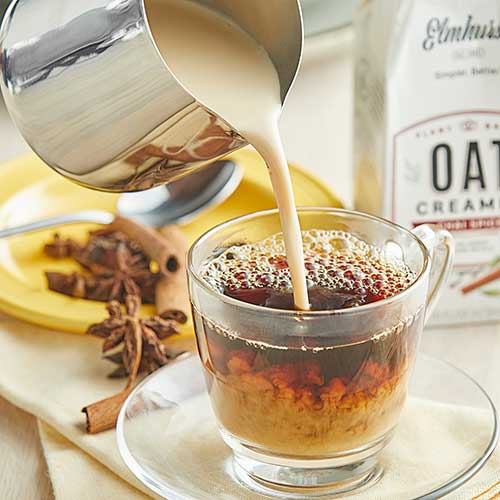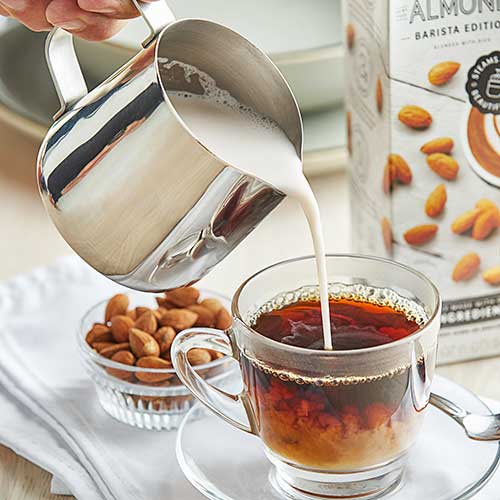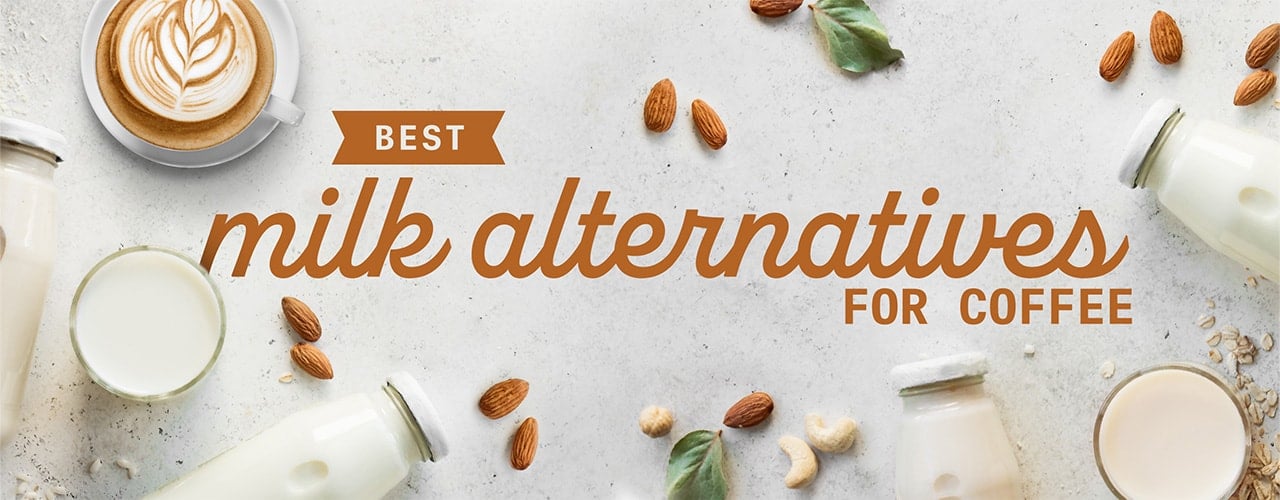Best Milk Alternatives for Coffee
Last updated on Jan 12, 2026Christine PottsIf you own a coffee shop or cafe, you know there are many ways to make a good cup of coffee. Each customer has different preferences, which you can accommodate by offering a diverse menu. Dairy-free milk has become extremely popular with vegans and omnivores alike, thanks to a growing interest in plant-based foods and alternatives.
If you want to offer options for vegan customers and lactose-intolerant patrons, it's important to know what kind of dairy-free milk is best in coffee. In this guide, we examine eight alternatives to dairy milk and the key factors that determine their compatibility with coffee.
Shop All Non-Dairy and Dairy-Free MilkDairy Free vs Non dairy
The words dairy-free and non-dairy are often used interchangeably, but they mean different things. Dairy-free products are completely devoid of animal products such as milk and yogurt and are often made from alternatives such as nuts or seeds. On the other hand, non-dairy products can still contain trace amounts of dairy products such as whey or casein. When creating a menu consisting of milk alternatives, ensure that you’re accurately labeling your food items to eliminate confusion.
What Makes a Dairy Free Milk Good in Coffee?
For each option in this blog, we’ll tell you how the milk alternative affects the taste or texture of your coffee and whether it has a good "stretch". In coffee terms, stretch is the ability to produce foam for different types of steamed coffee drinks like lattes and cappuccinos. Protein molecules melt when they are heated, so incorporating air into heated milk or dairy-free milk causes these proteins to trap the air and stretch the milk into foam. With these factors in mind, you can decide which options are best for your establishment’s coffee service.
1. Oat Milk

Oat milk has become one of the most popular dairy-free milks to use in coffee drinks. It's made from a combination of oats, water, and sometimes canola oil or rapeseed oil for emulsification. The result is surprisingly full-bodied dairy-free milk with a richness that rivals whole dairy milk.
Oat milk is also prized for its fiber content. This dairy-free milk appeals to health-conscious customers because it contains relatively little fat without sacrificing the protein that you can get from dairy milk. The addition of fiber, however, sets this dairy-free milk apart and makes it the perfect choice for customers who are looking to boost their digestive health.
How Oat Milk Tastes in Coffee
Oat milk has a creamy taste that is similar to full-fat dairy milk in coffee. It has a smooth texture that blends easily, which explains why it is growing in popularity so rapidly.
Can Oat Milk Make Foam for Coffee?
Oat milk can be foamed, though it may produce larger bubbles than dairy milk due to its lower protein content. Oat milk may also take longer to foam and steam than cow’s milk. This being said, it can still produce a foam substantial enough to create latte art.
2. Coconut Milk
Prized for its thick, creamy texture, coconut milk is quickly becoming a favorite dairy alternative for coffee drinkers. Coconut milk has a high fat content that plays well in coffee drinks, and many brands have a neutral taste with only a hint of coconut flavor. Just make sure to use the coconut milk packaged in cartons, not cans. Canned coconut milk is much thicker and has a stronger coconut taste.
How Coconut Milk Tastes in Coffee
Many assume that coconut milk has a strong, sweet flavor that only belongs in a tropical fruit drink. Coconut milk actually has a more subtle coconut flavor than other coconut products like shredded coconut. In coffee drinks that contain syrups or other flavorings, the light coconut taste is masked. In a latte or cappuccino, some sweetness will come through. Look for a coconut milk product that is neutral-flavored or try a barista blend created specifically for coffee.
Can Coconut Milk Make Foam for Coffee?
Coconut milk creates a less dense froth with larger bubbles than dairy milk.
3. Soy Milk
Most coffeehouses are accustomed to using soy milk in coffee, as this type of dairy-free milk has been a popular option for many years. Soy milk is easily accessible in most areas, and its relatively affordable price makes it an attractive option for many businesses.
Some soy milk curdles in coffee as a reaction to the acidity or hot temperature. Soy milks without preservatives may be more prone to separating in your customers’ coffee. If you think temperature is the problem, try pouring warm soy milk into your serving cup and slowly adding the coffee.
How Soy Milk Tastes in Coffee
Soy milk has a smooth, creamy texture with a relatively neutral taste. Many brands do not leave any noticeable aftertaste.
Can Soy Milk Make Foam for Coffee?
Soy milk’s good stretch is one reason it has been a popular alternative to dairy milk for so long. Knowledgeable baristas can produce a foam similar to that of dairy milk when using soy milk.
4. Rice Milk
Because this dairy alternative is both nut- and soy-free, it is growing in popularity for coffee drinkers with allergies and lactose sensitivities. If you want a hypoallergenic option for your coffee shop, rice milk could be the dairy-free milk for you.
How Rice Milk Tastes in Coffee
Rice milk has a very neutral taste that allows the flavor of your coffee to come through. However, its thin and watery texture does not give coffee the creamy consistency that some customers want with their beverage.
Can Rice Milk Make Foam for Coffee?
Rice milk does not contain enough protein to create a satisfactory foam in steamed drinks.
5. Cashew Milk
More and more people are reaching for cashew milk because of its creamy texture that mimics dairy milk in coffee. This being said, many baristas argue that house-made cashew milk is better for taste and steaming. If you want to incorporate cashew milk into your coffee offerings, weigh the costs and benefits of producing your own.
How Cashew Milk Tastes in Coffee
Cashew milk has a slightly sweet taste that is less nutty than other nut milk.
Can Cashew Milk Make Foam for Coffee?
Cashew milk has a decent stretch when it comes to steaming, but its bubbles tend to be larger, so its foam is less dense than dairy milk. If you aren’t careful, cashew milk may produce a soapy texture when steamed.
6. Pea Milk
Because pea milk is made from the protein of yellow peas, it doesn’t have the green color you might expect it to have. Pea milk has a relatively high protein content compared to other dairy-free alternatives, and it also contains a healthy dose of potassium.
How Pea Milk Tastes in Coffee
Many people name pea milk the best substitute for dairy milk in terms of taste. This smooth and neutral dairy-free milk does not taste like peas and won’t leave a vegetal aftertaste in your lattes.
Can Pea Milk Make Foam for Coffee?
Like other high-protein milk alternatives, pea milk is good at making foam for coffee beverages. Its foam has a silky texture that allows experienced baristas to make latte art.
7. Almond Milk

Almond milk is one of the most popular nut milks in the dairy-free market. It comes in several flavors, and many manufacturers produce both sweetened and unsweetened varieties. However, when it comes to coffee, almond milk doesn't perform as well as some other dairy-free milks.
Unfortunately, almond milk can curdle in coffee for the same reasons as soy milk: temperature and acidity. To combat curdling, avoid pouring cold almond milk into very hot coffee. Its reaction to the acidity of your coffee may vary between types of coffee roasts and brands, so be sure to try several options if you want to make almond milk a mainstay on your beverage menu.
How Almond Milk Tastes in Coffee
Almond milk has a nutty flavor that can sometimes taste bitter. Your customers may prefer sweetened almond milk in coffee for a smoother taste.
Can Almond Milk Make Foam for Coffee?
You can create a silky foam with almond milk, but this dairy-free milk tends to separate when heated. Latte art made with almond milk may look nice on top of the beverage's foamy layer, but it could leave a watery drink underneath.
If you want to accommodate lactose intolerant and vegan customers in your coffee shop, it is important to select a dairy-free milk option that can create delicious coffee drinks. You'll find that when you compare soy milk vs almond milk or oat milk vs coconut milk, some options dissolve better than others, and some milks are better suited for making foam in lattes and cappuccinos. Choose an alternative that does not take away from the taste of your house blends and remember to use this blog as a reference as you weigh your options.



